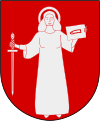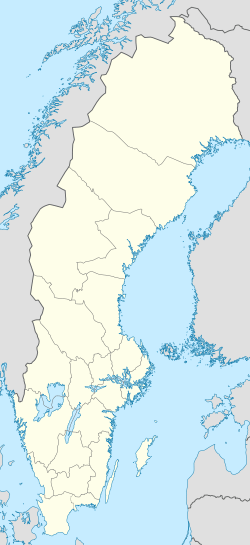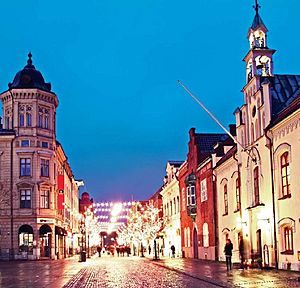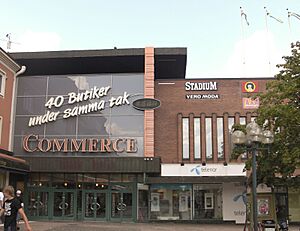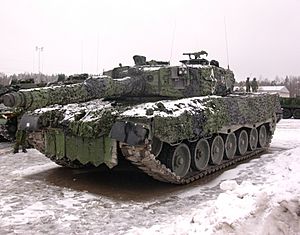Skövde facts for kids
Quick facts for kids
Skövde
|
||
|---|---|---|
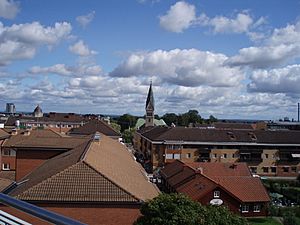
Skövde
|
||
|
||
| Country | Sweden | |
| Province | Västergötland | |
| County | Västra Götaland County | |
| Municipality | Skövde Municipality | |
| Area | ||
| • Total | 20.31 km2 (7.84 sq mi) | |
| Population
(31 December 2021)
|
||
| • Total | 57,061 | |
| • Density | 1,697/km2 (4,400/sq mi) | |
| Time zone | UTC+1 (CET) | |
| • Summer (DST) | UTC+2 (CEST) | |
Skövde is a lively town and a major center in Skövde Municipality and Västra Götaland County. It is located in the Västergötland region of central southern Sweden.
Skövde is about 150 kilometers (93 miles) northeast of Gothenburg. It sits between Sweden's two biggest lakes, Vänern and Vättern. The town is built on the eastern side of a small mountain ridge called Billingen, which is 304 meters (997 feet) high. This ridge cuts across the flat land between the lakes. In the 1850s, the Western Main Railway was built through Skövde. This railway helped the town grow a lot in both industry and population.
Today, Skövde is home to the main court for the Skaraborg area. It is the fourth-largest urban area in Västra Götaland. It is also Sweden's 32nd biggest town by population, with 39,580 people living there in 2020.
Contents
Discover Skövde's Past
Skövde has a long history that goes back to the Middle Ages. The town's coat of arms shows Saint Elin, also known as Saint Helena. She was a very religious woman from Skövde, born around 1101. She became a saint in 1164.
Most of the old medieval buildings in Skövde are gone. A big fire in 1759 burned down almost the entire city. Only a few houses, like those in Helensgården, survived. After the fire, the city was rebuilt with a clear grid pattern for its streets. Skövde was a small town until the railway connecting Stockholm and Gothenburg was built through it. This railway brought a huge boost in industry and population.
Early History: Before the 1500s
Saint Elin, Skövde's special saint, lived in the 12th century. Stories say she was killed on her way to a church event. She was made a saint on July 30, 1164, by Pope Alexander III. During the Middle Ages, many people traveled to visit Elin's grave. This helped Skövde grow and become an important city.
Skövde was a successful city in the Middle Ages. Its economy was strong, and it became quite important. There were three churches near the city: the City Church, the Elin Chapel, and Holy Birgitta's Chapel. The city itself might not have been very big in size or population. Its importance came from being the home of Saint Elin. Pilgrims came to see where she lived and was buried. The business from these pilgrims was key to Skövde's growth for many years.
We don't know the exact year Skövde officially became a town. But it was likely around 1400, as it was mentioned in tax records then. In the early 1500s, King Gustav Vasa officially confirmed Skövde's town rights.
Challenges and Changes: 1500s to 1759 Fire
The 15th century was good for Skövde, but the 16th century brought challenges. The main reason was the Reformation, which changed the country to the Lutheran faith. This movement wanted to remove saint worship from churches. Churches were emptied of treasures and relics, and Skövde was also affected.
Pilgrims stopped coming to Skövde, and a lot of the town's income disappeared quickly. King Gustav Vasa even thought about moving Skövde and other towns to Lake Hornborga. He wanted to build one big city there.
In 1520, Skövde faced its first recorded major setback. The Danish King, Kristian II, attacked Sweden. One of his armies swept through Västergötland and burned down Skövde, Falköping, Skara, and Bogesund (now Ulricehamn).
We have better ideas of Skövde's population starting in the 17th century. In 1655, the town had 134 people. This included farmers, housewives, children, and workers. By 1669, the population had grown to 168 people.
In the early 1700s, Skövde was one of the smallest towns in the county. In 1700, it had only 154 people. But 50 years later, the population had grown to 381. By 1770, it reached 500 people. During this time, Swedish towns had to house prisoners of war. These were soldiers captured by Karl XII's armies.
In 1708, there were 56 prisoners of war in Skövde. The town's rules said that every citizen had to take care of a prisoner. By 1718, there were 90 Danish prisoners. This meant prisoners of war made up a large part of small Skövde's population.
In 1746, Carl von Linné, a famous scientist, visited Skövde during his journey through Västra Götaland. He wrote about the area's plants and industries. When he arrived in Skövde on June 27, he didn't have many good things to say. He called it a "very small spot" with "small houses" and "irregular streets." He noted that it was once the home of Saint Helena.
The year 1759 brought a disaster: a huge fire destroyed central Skövde. A group of old wooden houses survived this fire. These houses, along with a botanical garden, now form the beautiful Helénsparken. The oldest house there, Helénsstugan, is from the early 1700s. Near Hertig Johan's Torg (Duke Johan's Square) is Saint Helena's Church and its park.
Skövde After the Great Fire
Skövde recovered well after the 1759 fire. Social life became active, with many balls and plays. People in the town lived a safe and pleasant small-town life. However, new changes were coming that would shape the city's future.
In the early 1860s, Skövde was still limited to what is now the old city. There were no big factories yet. Most people worked in handicrafts, trade, and farming. Agriculture and raising animals were the main jobs until the 1850s. After that, city-based businesses started to grow.
In the early 1800s, Skövde had very few police officers. The town's police force had only one permanent officer. His uniform cap showed his authority. His weapon was a wooden stick. He was also responsible for carrying out punishments like flogging.
Most houses in Skövde in the early 1800s were one-story. Their roofs were often covered with straw, reeds, peat, or wooden boards. It wasn't until 1850 that brick roofs became common.
During the first half of the 19th century, Skövde held six or seven markets each year. In 1847, special market square days were introduced, which soon became regular market days. Eventually, markets were limited to twice a year, once in spring and once in autumn. A very important market was the horse market, held every year on September 19. It was famous even outside Sweden. Buyers from cavalry and artillery groups, and even from Norway, Denmark, and Germany, came to buy young horses. Thousands of horses could be sold in a single day.
On April 2, 1832, it was decided that streets would be named. Before this, all properties were just numbered. Street addresses became common later, but even in the 1930s, plot numbers were still used for mail.
In 1858, Skövde's population grew, and the railway was soon finished. The Western Main Line opened in 1859. People started discussing having a local newspaper. They contacted the editor of Göteborgs Handels- och Sjöfartstidning, S.A. Hedlund, who agreed to provide news. The newspaper was called Sköfde Tidning and was published every Saturday. The first issue came out on November 13, 1858. In 1960, this paper joined with another local paper.
On June 18, 1870, a spa for water therapy opened near the railway station. This made Skövde a popular spa town for a short time. The spa was founded by Dr. Lars G Dovertie and was very popular in the 1870s and 1880s. Since 1992, the spa building has been used by the student union.
In 1884, a company was formed to build an indoor riding arena. The city gave land for this just north of town. This riding school later became important in discussions about bringing military regiments to Skövde. In 1889, there was a plan to move the Life Regiment Hussars' recruit school to Skövde. In 1891, it was decided that Skövde would get the regiment in two years. However, by late 1894, Örebro became a competitor. Örebro had advantages, like a large indoor riding arena. But after new offers from Skövde, the town won. Since 1896, the Hussars Recruit School has been in Skövde.
The second half of the 20th century saw a lot of rebuilding in Skövde. New parking lots and large buildings were created. Some old parts of the city, especially the wooden houses in the western old town, were removed. The 20th century in Skövde was also strongly shaped by the presence of the military. Military personnel were a common sight on Skövde's streets, though less so by the end of the century and into the new millennium.
Skövde's Weather and Climate
Skövde has a mix of oceanic and continental weather. The town is on the side of a hill, which means nights are warmer than in Skara, which is on the other side of the same higher area. In July 2018, Skövde had an average temperature of 22°C (72°F) during a heatwave. This was one of the few times a Swedish weather station met the definition of a hot summer. However, Skövde is not usually very warm. Summers are generally cooler than on Sweden's east coast. This is because strong low-pressure systems from the North Atlantic bring a lot of rain. Skövde is also 150 meters (492 feet) above sea level. Still, it gets less rain than areas to its south, like Borås and parts of Halland County, which are more affected by ocean weather.
| Climate data for Skövde (2002–2021 averages, extremes since 1915) | |||||||||||||
|---|---|---|---|---|---|---|---|---|---|---|---|---|---|
| Month | Jan | Feb | Mar | Apr | May | Jun | Jul | Aug | Sep | Oct | Nov | Dec | Year |
| Record high °C (°F) | 10.1 (50.2) |
14.9 (58.8) |
19.5 (67.1) |
27.2 (81.0) |
29.0 (84.2) |
34.0 (93.2) |
34.3 (93.7) |
34.1 (93.4) |
26.0 (78.8) |
22.0 (71.6) |
15.7 (60.3) |
12.2 (54.0) |
34.3 (93.7) |
| Mean maximum °C (°F) | 7.1 (44.8) |
7.9 (46.2) |
13.0 (55.4) |
19.5 (67.1) |
24.6 (76.3) |
27.1 (80.8) |
28.4 (83.1) |
27.3 (81.1) |
22.4 (72.3) |
16.1 (61.0) |
11.4 (52.5) |
8.1 (46.6) |
30.0 (86.0) |
| Mean daily maximum °C (°F) | 1.2 (34.2) |
1.6 (34.9) |
5.6 (42.1) |
11.7 (53.1) |
16.5 (61.7) |
20.4 (68.7) |
22.3 (72.1) |
20.9 (69.6) |
16.6 (61.9) |
10.4 (50.7) |
5.8 (42.4) |
2.8 (37.0) |
11.3 (52.4) |
| Daily mean °C (°F) | −1.1 (30.0) |
−0.9 (30.4) |
2.2 (36.0) |
7.1 (44.8) |
11.9 (53.4) |
15.8 (60.4) |
18.0 (64.4) |
16.9 (62.4) |
13.1 (55.6) |
7.7 (45.9) |
3.8 (38.8) |
0.8 (33.4) |
7.9 (46.3) |
| Mean daily minimum °C (°F) | −3.3 (26.1) |
−3.3 (26.1) |
−1.3 (29.7) |
2.5 (36.5) |
7.3 (45.1) |
11.2 (52.2) |
13.7 (56.7) |
12.8 (55.0) |
9.5 (49.1) |
4.9 (40.8) |
1.7 (35.1) |
−1.3 (29.7) |
4.5 (40.2) |
| Mean minimum °C (°F) | −12.9 (8.8) |
−12.1 (10.2) |
−8.7 (16.3) |
−2.8 (27.0) |
1.1 (34.0) |
6.5 (43.7) |
9.4 (48.9) |
7.8 (46.0) |
3.5 (38.3) |
−1.9 (28.6) |
−5.9 (21.4) |
−9.7 (14.5) |
−15.7 (3.7) |
| Record low °C (°F) | −28.9 (−20.0) |
−26.4 (−15.5) |
−22.0 (−7.6) |
−13.4 (7.9) |
−5.0 (23.0) |
0.0 (32.0) |
4.0 (39.2) |
0.5 (32.9) |
−3.7 (25.3) |
−9.0 (15.8) |
−16.8 (1.8) |
−26.0 (−14.8) |
−28.9 (−20.0) |
| Average precipitation mm (inches) | 48.9 (1.93) |
40.6 (1.60) |
37.3 (1.47) |
35.0 (1.38) |
64.2 (2.53) |
82.7 (3.26) |
88.1 (3.47) |
87.9 (3.46) |
59.3 (2.33) |
68.3 (2.69) |
62.0 (2.44) |
55.4 (2.18) |
729.7 (28.74) |
| Source 1: SMHI Open Data for Skövde, precipitation | |||||||||||||
| Source 2: SMHI Open Data for Skövde, temperature | |||||||||||||
Skövde's Economy and Jobs
Skövde is an important center for many different types of businesses.
Volvo and Aurobay: Car Engines
Aurobay (which used to be part of Volvo Cars) and Volvo Group Truck Operations (part of the Volvo Group) run one of the world's largest car engine factories in Skövde. These two companies are the biggest employers in Skövde. The Volvo Group Truck Operations plant is AB Volvo's largest factory for industrial diesel engines worldwide. They make engine parts like engine blocks and cylinder heads. Aurobay makes eco-friendly hybrid engines for Volvo Cars and other customers. They can produce 600,000 engine systems each year. In 2021, the Swedish Environmental Protection Agency gave them money to change part of the Skövde factory to make parts for electric vehicles. In 2011, these two factories together had over 4,000 full-time employees.
Other Industries and Public Services
Skövde has many different types of industries. These include CEJN AB, which makes quick connectors for air and water. Furhoffs Rostfria makes stainless steel products like sinks. Cementa produces cement, and Grahns Konfektyr makes sweets.
Many people in Skövde work for public services. The biggest public employer is the Skövde Municipality. Other important public employers include the Swedish Armed Forces, Skaraborg Hospital, and the University of Skövde. The Skaraborgs District Court, the Swedish Police, and Västtrafik (public transport) also provide many jobs.
Skövde has grown a lot as a shopping center recently. Retail sales in the city have increased by 40% in the last 10 years. This growth in trade creates many jobs in small and medium-sized businesses.
Skövde is also a hub for game development. In the Gothia Science Park, there are many game companies that create games. The University of Skövde has a large game development program. This closeness helps Skövde be a strong center for making games.
Because Skövde has so many different job opportunities, many people travel to the city for work from nearby towns every day.
Shopping and Retail Areas
Skövde is a great place to shop with many choices. The city center is the biggest shopping area in Skaraborg County. It has over 40 shops and restaurants. It is right next to Hertig Johans Torg and Sandtorget and has its own parking. You can find big brands and smaller shops here. In October 2008, the renovated Vasaporten shopping mall opened. It has a dozen shops, a new entrance to the Willys grocery store, and 500 parking spaces.
Norrmalm's shopping area has about twenty shops along Gustavus Adolphusgatan. Here you'll find a big, new shopping center called Elins Esplanad. It has 30 shops, an Ica Maxi Supermarket, and restaurants. There are thousands of free parking spaces, including 200 in a garage. Elin's Esplanade opened on November 28, 2008.
Stallsikens is a brand new shopping area for large stores. Big stores like auto parts store Biltema, garden store Plantagen, and furniture retailer Mio are located here. Other stores include discount retailer Ö&B, home decor store Chili, and electronics store Media Markt. These stores opened in stages, starting in spring 2008.
Skövde has three main shopping areas: the city center, Norrmalm, and Stallsiken. All are easy to reach. There are also specific shops in other areas like Aspelund, Hasslum, and Mariesjö.
Culture and Fun in Skövde
The Skövde Kulturhus (Civic Cultural Centre) was built in 1964. It was Sweden's first cultural center to bring many different cultural activities under one roof. The building was designed by architect Hans-Erland Heineman. It has an art gallery, art museum, library, theater, and cinema.
Museums to Explore
Skövde's City Museum used to be in the Old Town Hall. After 2005, the museum moved to Norrmalm. In the museum, you can find old letters, legal papers, maps, and newspaper clippings. The archive also has thousands of photos of Skövde and portraits from the 1800s. There are almost 40,000 objects in storage, but not all are listed yet.
There is also an outdoor exhibit in the city center called Helénsgården. This is the only building that survived the big fire of 1759, which destroyed most of the town. Helénsgården was likely built in the early 1700s. Today, it is a protected cultural site. Its park is a popular meeting place and is used for events like Sweden's National Day.
At the Skövde military base, you can visit the Garnisonsmuseet (Garrison Museum). It has exhibits about military life and soldiers throughout history. The central soldier register there is also very helpful for learning about family history.
The Skövde Sport History Museum, opened in 2001, is in the basement of Billingehus. Here, you can learn about the city's sports history through sounds, images, old trophies, and sports gear.
The Volvo Museum tells the story of the Sköfde Foundry and Mechanical Workshop, which started in 1868. It shows how it became the car industry we know today. The Ryttmästarbostället (Stablemaster's Residence) is near Simsjön outside Skövde. A non-profit group runs it. Their goal is to keep the buildings and items from the old military system and share them with the public.
Music and Shows
Skövde often hosts music events. Loke is a local group that organizes "amateur nights." Here, new musicians can play and even borrow instruments. Valhall is another local group, right next to Loke in the Kulturhus. They host concerts with famous bands like Mustasch and Hardcore Superstar.
In winter, Arena Skövde is often used for big concerts with popular artists. In summer, outdoor areas like Karstorp recreation area or Boulognerskogen (Boulogner Forest) are used for events.
Theater Performances
You can watch theater shows at the City Theatre, which is in the Kulturhus. They put on all kinds of shows, from funny plays to children's theater. Eric Ugglas Theatre is another venue, located slightly south of Skövde's city center.
The Food Festival
The Food Festival is a popular event in Skövde. It started in 1990 and is always held on the last weekend in August. The festival focuses on food served in small portions from different restaurants in the city. The restaurants also compete to see who makes the best food, as voted by the festival visitors. The Food Festival also has a fun amusement park on Sandtorget and a market hall on Hertig Johans Torg.
Skövde's Military Presence
Skövde is home to important military units. The armored corps regiment Skaraborg Regiment (P 4) and the logistics corps regiment Göta Logistic Regiment (T 2) are both located here. The Army Combat School is also in Skövde.
Military History
Around the year 1900, several Swedish Army units moved to Skövde. In 1913, the Skaraborg Regiment also moved here. This cost the city a lot of money but also helped increase business and spending. Today, the military base in Skövde is one of the largest in Sweden.
Active Military Units Today
Skövde has several active military units. These include the Skaraborg Regiment (P 4) and the Göta Logistic Regiment (T 2). The Göta Logistic Regiment also includes the Swedish Armed Forces Logistics and Motor School (LogS) and the Land Warfare Centre (MSS). P 4 mainly trains units that use tanks and other armored vehicles. TrängR trains different types of logistics units. The Land Warfare Centre trains officers for land combat and develops new methods. The Logistics School trains students and staff from the Army, Navy, and Air Force in military science, technology, leadership, and combat. It works with the Armed Forces Logistics Regiment Centre of Excellence in Logistics. Recent decisions have increased the role of Skövde's military base. Smaller units, like the Armed Forces Engine School, have moved to Skövde.
The troops in Skövde also have new duties. They help set up and staff positions for the Nordic Battle Group. This is a task force that is part of the European Union's battlegroup concept. Skövde's military base provides about 230 soldiers and officers for a logistics unit. It also provides nearly 100 people for an infantry unit's staff. Plus, there are a few independent platoons. More troops are part of a separate mechanized operation company called IA07.
Education in Skövde
Skövde offers many educational opportunities, from university to high school.
University of Skövde
The University of Skövde is a university with over 9,000 students. It conducts research and offers many courses. Currently, its main focus areas are information technology and systems biology. The university trains biologists, computer scientists, economists, engineers, cognitive scientists, nurses, linguists, and teachers. The University of Skövde is known for its courses that combine different subjects. These courses bring together technology, natural science, and humanities.
Other Schools and Training
On the edge of the city is the Skövde Garrison, one of Sweden's largest military bases. It has two regiments: the Skaraborg Regiment (P 4) and the Göta Logistic Regiment (T 2). It also includes the Logistics School and the Land Warfare Centre.
The Rescue and Survival College (Räddningskolan) offers training and certifications. They teach about rescue, fire safety, and international humanitarian work. They also have hotel rooms and conference facilities for rent.
The Swedish Rescue Training Centre (SRTC) is in Hasslum. It also provides education and training in risk and safety.
Skövde has two public high schools: Västerhöjdsgymnasiet and Kavelbrogymnasiet. They now operate together as Gymnasium Skövde. There is also a public adult education school called Komvux.
Sports in Skövde
Skövde is well-known for its handball teams. However, the town also has other sports played at a high level, like baseball, softball, and taekwondo.
Handball Teams
Skövde's handball teams play at the highest level for both men and women. The men's team, IFK Skövde, has played in the elite series (Elitserie). In 2005, they played in the final against Sävehof but lost by a very small margin. In 2007, they were in the final again, this time against Hammarby IF, who won the match. The women's team, Skövde HF (Handbollsflickor – handball girls), is also in Sweden's top division. They played in five finals over several years. In 2008, they became Swedish champions after beating IK Sävehof 31−24.
Orienteering Events
Skövde hosted the 1989 World Orienteering Championships. The 2002 O-Ringen, a large orienteering event, was also held in Skövde.
Sports Clubs and Associations
- IFK Skövde HK – Handball club
- Skövde HF – Handball club
- HP Skövde 90 – Handball club
- Skövde IK – Ice hockey club
- Skövde AIK – football (soccer) club
- Skövde KIK – Football (soccer) club
- IFK Skövde Fotboll Klubb – football (soccer) club
- Våmbs IF – Football (soccer) club
- FC Södra Ryd – Football (soccer) club
- Skövde IBF – Floor hockey association
- Föreningen SkövdeBor – Stockholm-based expatriate association
- Skövde Saints BSK – Baseball and Softball club
- IFK Skövde Friidrott – Athletics association
- IF Hagen Friidrott – Athletics association
- IF Hagen Orientering – Orienteering association
- Orienteringsklubben P 4 – Orienteering association
- Skövde Dukes – American football (gridiron) club
- IF Hagen SK – Ski club
- IFK Skövde Skidklubb – Ski club
- IF Skövde Karate Kai – Karate and Martial Arts
- Skövde ABK – Athlete- and Wrestling Club
- Skövde Bandy – Bandy association
- Skövde BC – Boxing club
- Skövde Bågskytteklubb – Archery club
- Skövde CK – Cycling club
- Skövde GF – Gymnastics association
- Skövde GK – Golf club
- Skövde Judo – Judo club
- Skövde KK – Figure Skating club
- Skövde FK – Table Tennis club
- Skövde RF – Equestrian association
- Skövde SS – Swimming association
- Skövde Taekwon-do Club – Taekwondo club
- Skövde Tennisförening – Tennis association
- Skövde VBK – Volleyball association
- S:t Helena Basket – Basketball club
- Candanza DF – Dance association
Skövde Airport
Skövde Airport is about 10 kilometers (6 miles) from Skövde. Currently, there are no regular flights. However, there is an active flying club and gliding club. At least one company jet is also based at the airport.
Interesting Facts About Skövde
In 1904, the largest gold treasure in the Nordic region, called Timboholmsskatten, was found in Skövde. Two farmhands, Carl Wernlund and Per Rythén, found it. The treasure is made of 24 carat gold and weighs over 7 kilograms (15 pounds). It includes 16 rings and two gold bars. Today, the original treasure is at the Swedish Museum of National Antiquities in Stockholm. A copy can be seen at the Skövde City Museum. This treasure dates back to the later Migration Period, around the 5th to 6th centuries.
Famous People from Skövde
- Stig Bergström, a Swedish-American paleontologist, born in 1935
- Christian Älvestam, vocalist
- Fredrik Belfrage, television personality
- Helena Bergman, orienteering World Champion
- Mustafa Can, journalist
- Gustav Ejstes, musician (Dungen, Amason)
- Alfred Grenander, architect
- Thomas G:son, musician
- Robert Gustafsson, comedian
- Marcus Hellner, cross-country skier
- David Johansson, football player
- Michael Jonzon, golfer
- Andreas Larsson, handball player
- Kristina Lugn, poet
- Christian Magdu, actor
- Johan Mårtensson, footballer
- Johan Sjöstrand, handball player
- Tim Sköld, musician
- Petter Stymne, swimmer
- Oscar Wendt, footballer
- Gert Wingårdh, architect
See also
 In Spanish: Skövde para niños
In Spanish: Skövde para niños


